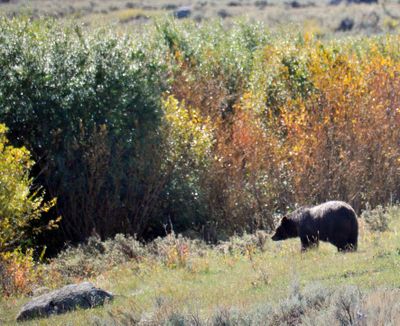Montana unveils plan to manage grizzlies

The state of Montana has released a draft of its first statewide plan for grizzly bear management, consolidating and updating two regional plans in one document.
The plan, once finalized, will guide the state’s management of the species under the Endangered Species Act. It would become the overarching grizzly management manual in Montana if the species is delisted from its “threatened” status under the federal Endangered Species Act.
The draft Montana Grizzly Bear Management Plan, released Tuesday by the Department of Fish, Wildlife & Parks, will take the place of two existing plans: a 2006 management plan for western Montana and a 2013 plan for southwest Montana. The western Montana plan guides management of the species around the Northern Continental Divide Ecosystem (NCDE). The southwest Montana plan guides management around the Greater Yellowstone Ecosystem (GYE).
The statewide plan was released in draft form with a draft Environmental Impact Statement (EIS) containing environmental analyses that underpin the draft plan. FWP is taking public comments on the draft management plan and the draft EIS. Comments are due by Jan. 5, 2023, and can be submitted via an online form, by emailing kmcdonald@mt.gov or by mailing Ken McDonald, Wildlife Division Administrator, Montana Fish, Wildlife & Parks P.O. Box 200701 Helena, MT 59620-0701.
Ken McDonald, FWP’s Wildlife Division administrator, told colleagues at the winter meeting of the Interagency Grizzly Bear Committee in Bozeman on Tuesday that he expected a final decision on the management plan and EIS around mid-February. He said the draft statewide management plan incorporates “pieces and parts” of the two regional plans it would replace, as well as input from the agency’s 2019–20 Grizzly Bear Advisory Council.
As long as grizzlies are listed as threatened under the Endangered Species Act, the bears’ management and recovery is overseen by the U.S. Fish and Wildlife Service. While the species is listed, the statewide management plan would guide FWP’s management of grizzlies within the constraints of the species’ federal protections and under federal oversight.
If the Fish and Wildlife Service delists the species – as Montana, Wyoming and Idaho are requesting – then grizzly management would fall to the states, alongside most other wildlife. In that case, the new statewide plan would become the authoritative guiding document for management of grizzlies in Montana.
Organizations outside of FWP, such as conservation and wildlife groups, have yet to fully analyze the draft plan. Clocking in at 217 pages, the draft statewide plan is longer than the current 177-page western Montana plan; it dwarfs the 81-page southwest Montana plan.
Following the release of the draft plan and EIS Tuesday, Derek Goldman, the national field director and northern Rockies senior field representative for the Endangered Species Coalition, said in a statement that the group would review the documents. But whatever it said, he argued Montana’s Legislature and governor are hostile toward grizzly bears, and the state shouldn’t have management authority over the species.
“Regardless of what the state puts in a plan, one need only look at the wolf and grizzly bear bills passed during the last legislative session and signed by the governor to realize that grizzly bear management by the state of Montana right now would be a disaster,” Goldman said. “Grizzly bears are a critical piece of our western wildlife heritage, and while we look forward to reviewing this draft plan, we will also continue emphasizing the dangers of transferring full management authority to a hostile state administration and Legislature.”
The draft plan states that it is “fully compliant with the Endangered Species Act (ESA) and will maintain commitments in existing agreements with federal, state, and tribal agencies.”
The draft plan states that it views populations in the NCDE and GYE as “having met recovery targets [which] supports their delisting,” and that “FWP supports federal policies for meeting recovery goals in the Cabinet-Yaak Ecosystem and for attaining natural recovery of a population in the Bitterroot Ecosystem; the latter is comprised largely of wilderness.
“FWP also takes the position – and this plan documents the case – that populations occupying the NCDE and GYE are abundant enough to provide dispersal opportunities for establishing connectivity among recovery ecosystems,” the draft states. “Therefore, FWP’s Preferred Alternative does not identify specific statewide population targets beyond those already referenced in the (federal) Recovery Plan or Conservation Strategies.”
The draft statewide management plan, which would cover 30 Montana counties in which grizzlies are currently or imminently present, said the agency believes that connectivity between ecosystems “can be attained by a lower number of dispersed animals navigating through those areas, instead of by full populations occupying the whole state.”
The plan “does not manage for grizzly bear presence outside of core areas, where the likelihood of conflict is elevated and legitimate concerns about human safety become the single highest priority.” Rather, decisions on managing individual grizzlies outside of core areas would depend on the likelihood of whether having an individual bear in a particular location “contributes to the long-term persistence and connectivity of the species.”
If the bear’s presence is likely to contribute to persistence and connectivity, the plan states, “FWP would make all reasonable efforts to recommend (or implement, if appropriate) actions that minimize bear removal.” If the agency determines that a bear’s presence is unlikely to contribute to persistence or connectivity, then “grizzly bear presence will not be an objective and FWP will be quick to recommend (or implement, if appropriate) control when conflicts arise.”